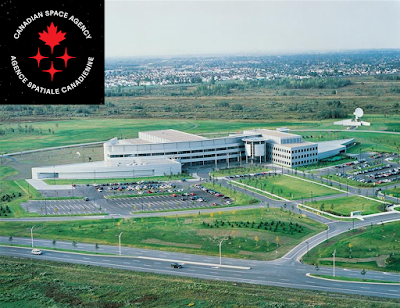Last fall and into the winter term, PVL PhD student Charissa Campbell completed an internship with the Canadian Space Agency. Internships with industry, other academic labs and government are a key part of life at the PVL, giving graduate students the opportunity to get to know career paths close up during their studies.
(Above: CSA headquarters in St-Hubert, QC with the Agency's new logo in the top-left corner)
By Charissa Campbell
From September 2022 until April 2023, I was completing an internship at the Canadian Space Agency (CSA) on top of my grad studies. Being a part of the Technologies for ExoPlanetary Science (TEPS) NSERC CREATE gave me the opportunity to do an internship in another (or similar) area of space exploration. This could be with another researcher or with a company such as MDA who created the Canadarm that is on the International Space Station. However, one area of expertise in space missions that I was particularly interested to learn more about was how the government prepares for a mission through their space agency. Luckily, we were able to find someone at the CSA who connected me with someone who could teach me these skills.
Based on my experience with the Curiosity rover and surface missions, I was added to the team working on the Lunar rover. Even though my expertise is with Mars, it was great to learn on the differences between Mars and the Moon. One big change is that the Lunar rover will be at the south pole, while Curiosity is at Mars’ equator, so solar lighting is extremely different than what I’m used to. This lighting is not unlike what you would find on Earth if you were to travel far up north. There are even some parts of the year that do not see the Sun for several months. However, if you are at the equator then the amount of sunlight throughout the year is very consistent. When planning for a rover at the pole, knowing how the sun lights up your workspace is very important for understanding power conditions.
There are several objectives for the rover, but the main one is to find water-ice on the Moon. Water has been thought to be in Permanently Shadow Regions (PSRs) on the Moon due to the little-to-no sunlight these regions receive. Having water directly on the Moon would significantly help future crewed missions as not only do we need water to live, but the Hydrogen in water could be used as a source of energy for rockets launched from the Lunar surface. Knowing that finding water-ice is the main objective of the rover, 6 payloads will be added. Five will be Canadian and the other will be provided by NASA. Canadensys Aerospace Corporation was selected as the Canadian company to build the rover and develop the Canadian payloads. These payloads include:
1) Lunar Hydrogen Autonomous Neutron Spectrometer will detect Hydrogen to help indicate if water-ice is nearby.
2) Frozen Regolith Observation and Science Tools (FROST) imaging suite contains three specific payloads:
i. Lyman-Alpha Imager will identify surface water-ice by investigating lunar surface sunlight reflectance.
ii. Multi-Spectral Imager will identify minerals in the lunar soil
iii. Multi-Spectral Imager Macro is similar to (ii) but with much higher resolution
3) Radiation Micro-Dosimeter will measure the amount of radiation at the surface to help determine the safety for future human crewmembers on the Moon.
Even though the launch isn’t till 2026 at the earliest, it is amazing to see Canadian technology and knowledge being developed for scientific missions. It will be the first time that Canada will send something to the Moon. The announcement for the Canadian rover can be seen here: https://www.asc-csa.gc.ca/eng/astronomy/moon-exploration/first-canadian-rover-to-explore-the-moon.asp
Overall, I really enjoyed the internship and learned a lot that could help my future career prospects. For the first four months of my internship, I dedicated my entire time to the CSA and moved to Montreal to attend my internship in-person. Many interns were still virtual, but I wanted to fully experience what it was like working at an agency. This includes getting my own cubicle (with my name!) and my own badge that I had to scan multiple times to reach my office. The opportunity to do this in-person was too hard to pass up, even though it was relatively hard on my family as my husband and 2-year old son stayed back in Ontario.
However, the CSA was extremely generous and allowed me to work-from-home every second Friday so that I could take the VIA train back home for that weekend to see my husband/son. I loved taking the train back/forth between Oshawa and Montreal and learned it was a great way to get some extra work done on the 4-hour one-way trip. At one point, my husband came down to Montreal with Arthur so he could see where Mommy was working for the past few months.
One perk of working in-person at the CSA is the extensive library. They have a variety of books and offer weekly colloquium sessions. This was my son’s favourite part as he got to read and play with their space shuttles while I completed a meeting. Even though I did love being in-person and really getting to network (including meeting astronauts!) I decided to do the last four months part-time and virtual so that I could be home with my family and work on finishing up my PhD.
Now that my time at the CSA is complete, I feel very happy with my decision to pursue this type of internship so that I could understand the finer details about how a mission goes from its early stages to being developed. It is rather a unique experience and I would recommend that if you are interested in an internship with the CSA to check out this webpage: https://www.asc-csa.gc.ca/eng/jobs/internships-and-student-jobs.asp. I look forward to watching the news in 2026 (or later) on the Canadian Lunar rover and its success on investigating water-ice at the Moon’s southern pole.


